INFINITI QX50 2019 Owner's Manual
Manufacturer: INFINITI, Model Year: 2019, Model line: QX50, Model: INFINITI QX50 2019Pages: 573, PDF Size: 7.4 MB
Page 541 of 573
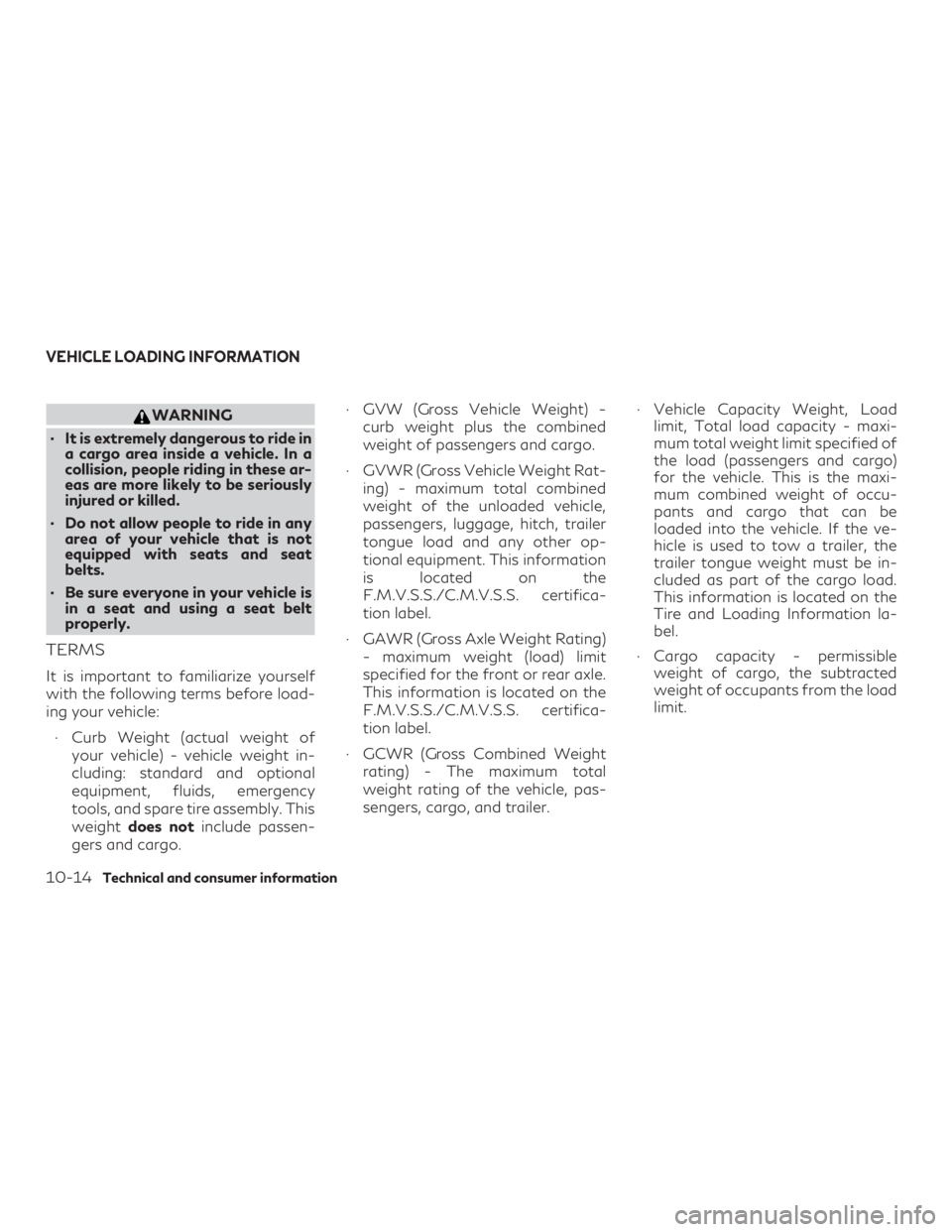
WARNING
∙ It is extremely dangerous to ride in a cargo area inside a vehicle. In a
collision, people riding in these ar-
eas are more likely to be seriously
injured or killed.
∙ Do not allow people to ride in any area of your vehicle that is not
equipped with seats and seat
belts.
∙ Be sure everyone in your vehicle is in a seat and using a seat belt
properly.
TERMS
It is important to familiarize yourself
with the following terms before load-
ing your vehicle:
∙ Curb Weight (actual weight of your vehicle) - vehicle weight in-
cluding: standard and optional
equipment, fluids, emergency
tools, and spare tire assembly. This
weight does not include passen-
gers and cargo. ∙ GVW (Gross Vehicle Weight) -
curb weight plus the combined
weight of passengers and cargo.
∙ GVWR (Gross Vehicle Weight Rat- ing) - maximum total combined
weight of the unloaded vehicle,
passengers, luggage, hitch, trailer
tongue load and any other op-
tional equipment. This information
is located on the
F.M.V.S.S./C.M.V.S.S. certifica-
tion label.
∙ GAWR (Gross Axle Weight Rating) - maximum weight (load) limit
specified for the front or rear axle.
This information is located on the
F.M.V.S.S./C.M.V.S.S. certifica-
tion label.
∙ GCWR (Gross Combined Weight rating) - The maximum total
weight rating of the vehicle, pas-
sengers, cargo, and trailer. ∙ Vehicle Capacity Weight, Load
limit, Total load capacity - maxi-
mum total weight limit specified of
the load (passengers and cargo)
for the vehicle. This is the maxi-
mum combined weight of occu-
pants and cargo that can be
loaded into the vehicle. If the ve-
hicle is used to tow a trailer, the
trailer tongue weight must be in-
cluded as part of the cargo load.
This information is located on the
Tire and Loading Information la-
bel.
∙ Cargo capacity - permissible weight of cargo, the subtracted
weight of occupants from the load
limit.
VEHICLE LOADING INFORMATION
10-14Technical and consumer information
Page 542 of 573

VEHICLE LOAD CAPACITY
Do not exceed the load limit of your
vehicle shown as “The combined
weight of occupants and cargo” on the
Tire and Loading Information label. Do
not exceed the number of occupants
shown as “Seating Capacity” on the
Tire and Loading Information label.
To get “the combined weight of occu-
pants and cargo”, add the weight of all
occupants, then add the total luggage
weight. Examples are shown in the
following illustration.
Example
LTI2320
Technical and consumer information10-15
Page 543 of 573
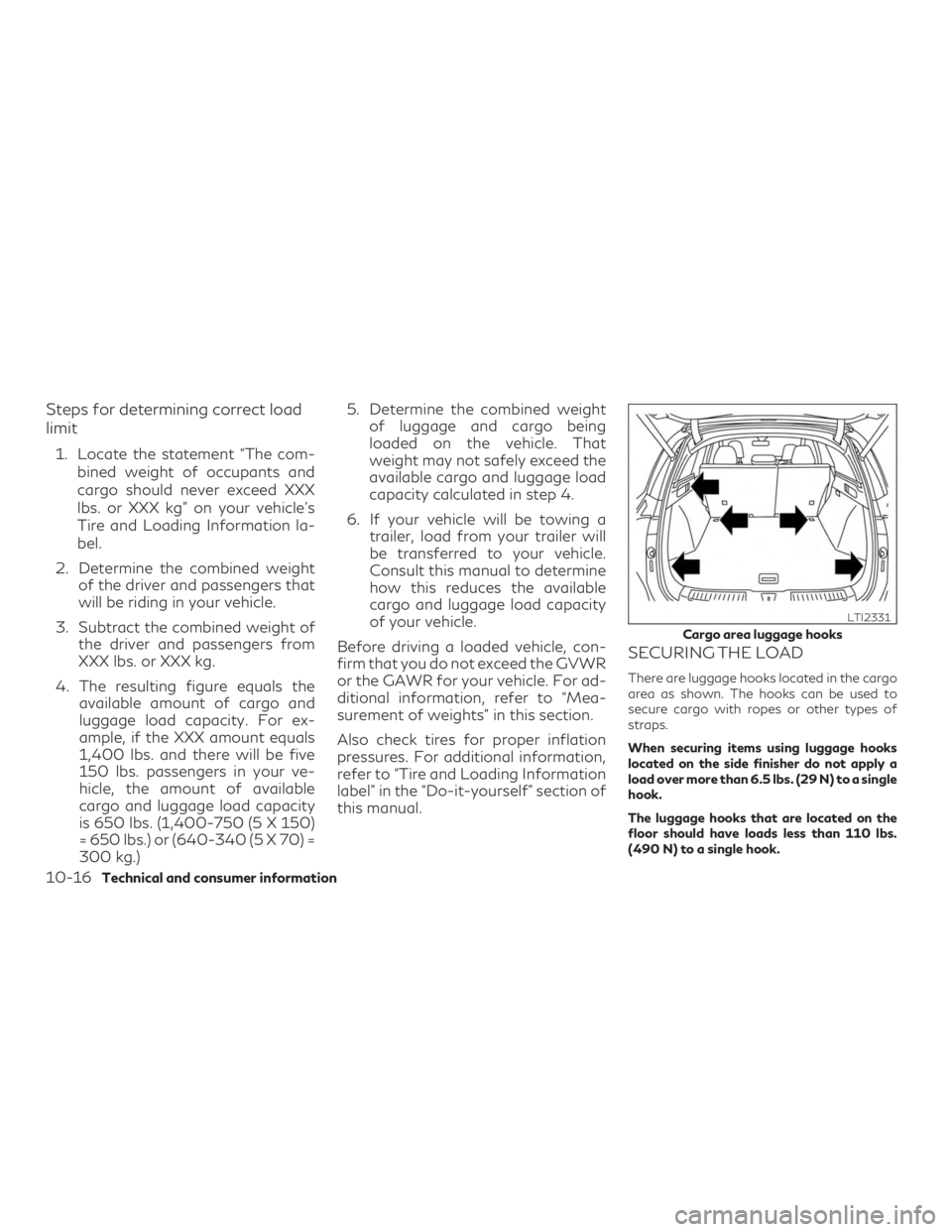
Steps for determining correct load
limit
1. Locate the statement “The com-bined weight of occupants and
cargo should never exceed XXX
lbs. or XXX kg” on your vehicle’s
Tire and Loading Information la-
bel.
2. Determine the combined weight of the driver and passengers that
will be riding in your vehicle.
3. Subtract the combined weight of the driver and passengers from
XXX lbs. or XXX kg.
4. The resulting figure equals the available amount of cargo and
luggage load capacity. For ex-
ample, if the XXX amount equals
1,400 lbs. and there will be five
150 lbs. passengers in your ve-
hicle, the amount of available
cargo and luggage load capacity
is 650 lbs. (1,400-750 (5 X 150)
= 650 lbs.) or (640-340 (5 X 70) =
300 kg.) 5. Determine the combined weight
of luggage and cargo being
loaded on the vehicle. That
weight may not safely exceed the
available cargo and luggage load
capacity calculated in step 4.
6. If your vehicle will be towing a trailer, load from your trailer will
be transferred to your vehicle.
Consult this manual to determine
how this reduces the available
cargo and luggage load capacity
of your vehicle.
Before driving a loaded vehicle, con-
firm that you do not exceed the GVWR
or the GAWR for your vehicle. For ad-
ditional information, refer to “Mea-
surement of weights” in this section.
Also check tires for proper inflation
pressures. For additional information,
refer to “Tire and Loading Information
label” in the “Do-it-yourself” section of
this manual.
SECURING THE LOAD
There are luggage hooks located in the cargo
area as shown. The hooks can be used to
secure cargo with ropes or other types of
straps.
When securing items using luggage hooks
located on the side finisher do not apply a
load over more than 6.5 lbs. (29 N) to a single
hook.
The luggage hooks that are located on the
floor should have loads less than 110 lbs.
(490 N) to a single hook.
Cargo area luggage hooks
LTI2331
10-16Technical and consumer information
Page 544 of 573

WARNING
∙ Properly secure all cargo with ropes orstraps to help prevent it from sliding or
shifting. Do not place cargo higher than
the seatbacks. In a sudden stop or colli-
sion, unsecured cargo could cause per-
sonal injury.
∙ The child restraint top tether strap may be damaged by contact with items in the
cargo area. Secure any items in the cargo
area. Your child could be seriously injured
or killed in a collision if the top tether
strap is damaged.
∙ Do not load your vehicle any heavier than the GVWR or the maximum front and
rear GAWRs. If you do, parts of your ve-
hicle can break, tire damage could occur,
or it can change the way your vehicle
handles. This could result in loss of con-
trol and cause personal injury.
LOADING TIPS
∙ The GVW must not exceed GVWR
or GAWR as specified on the
F.M.V.S.S./C.M.V.S.S. certifica-
tion label. ∙ Do not load the front and rear axle
to the GAWR. Doing so will exceed
the GVWR.
WARNING
∙ Properly secure all cargo with ropes or straps to help prevent it
from sliding or shifting. Do not
place cargo higher than the seat-
backs. In a sudden stop or collision,
unsecured cargo could cause per-
sonal injury.
∙ Do not load your vehicle any heavier than the GVWR or the
maximum front and rear GAWRs.
If you do, parts of your vehicle can
break, tire damage could occur, or
it can change the way your vehicle
handles. This could result in loss of
control and cause personal injury. ∙ Overloading not only can shorten
the life of your vehicle and the tire,
but can also cause unsafe vehicle
handling and longer braking dis-
tances. This may cause a prema-
ture tire failure which could result
in a serious accident and personal
injury. Failures caused by over-
loading are not covered by the ve-
hicle’s warranty.
MEASUREMENT OF WEIGHTS
Secure loose items to prevent weight
shifts that could affect the balance of
your vehicle. When the vehicle is
loaded, drive to a scale and weigh the
front and the rear wheels separately
to determine axle loads. Individual axle
loads should not exceed either of the
gross axle weight ratings (GAWR). The
total of the axle loads should not ex-
ceed the gross vehicle weight rating
(GVWR). These ratings are given on
the vehicle certification label. If weight
ratings are exceeded, move or remove
items to bring all weights below the
ratings.
Technical and consumer information10-17
Page 545 of 573
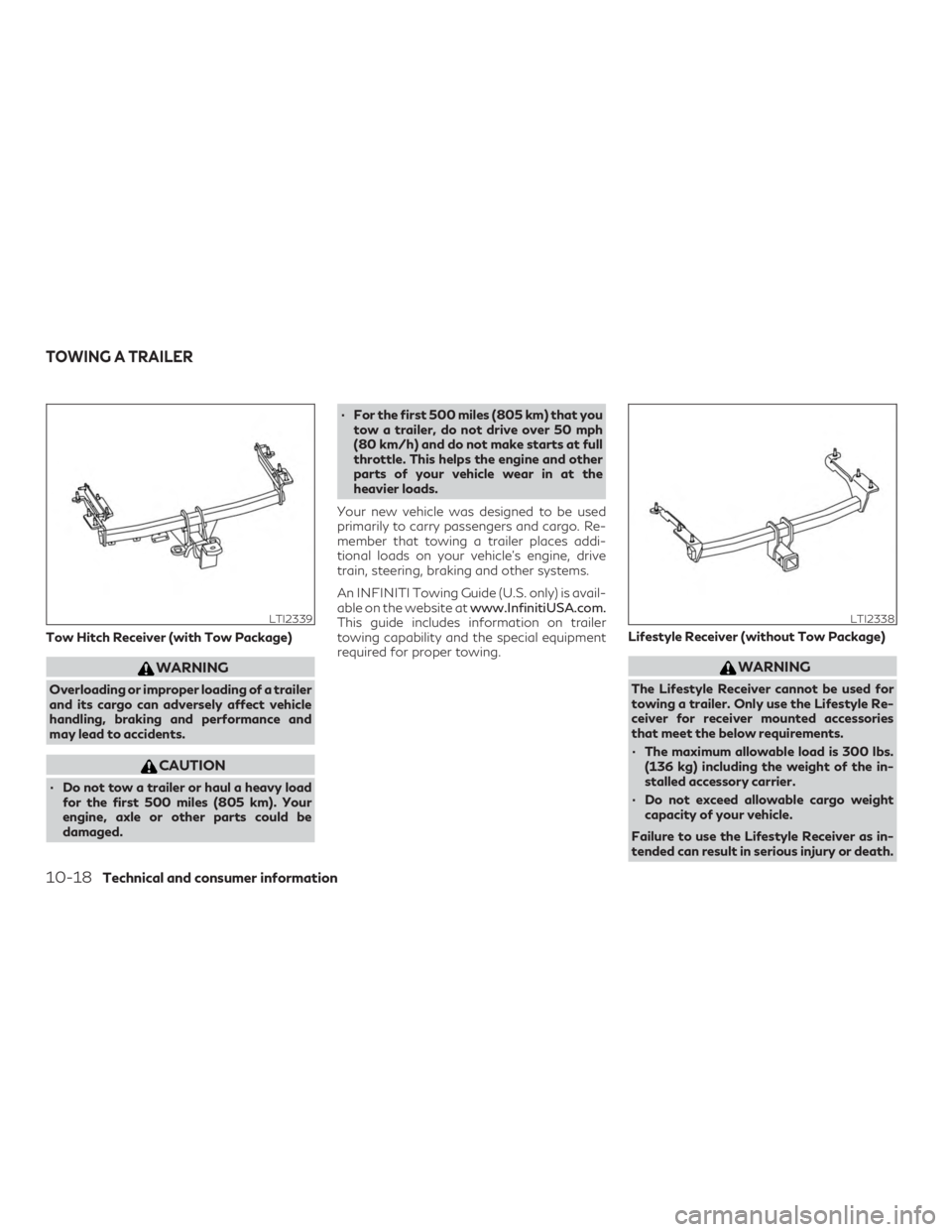
Tow Hitch Receiver (with Tow Package)
WARNING
Overloading or improper loading of a trailer
and its cargo can adversely affect vehicle
handling, braking and performance and
may lead to accidents.
CAUTION
∙ Do not tow a trailer or haul a heavy loadfor the first 500 miles (805 km). Your
engine, axle or other parts could be
damaged. ∙ For the first 500 miles (805 km) that you
tow a trailer, do not drive over 50 mph
(80 km/h) and do not make starts at full
throttle. This helps the engine and other
parts of your vehicle wear in at the
heavier loads.
Your new vehicle was designed to be used
primarily to carry passengers and cargo. Re-
member that towing a trailer places addi-
tional loads on your vehicle’s engine, drive
train, steering, braking and other systems.
An INFINITI Towing Guide (U.S. only) is avail-
able on the website at www.InfinitiUSA.com.
This guide includes information on trailer
towing capability and the special equipment
required for proper towing. Lifestyle Receiver (without Tow Package)
WARNING
The Lifestyle Receiver cannot be used for
towing a trailer. Only use the Lifestyle Re-
ceiver for receiver mounted accessories
that meet the below requirements.
∙ The maximum allowable load is 300 lbs.
(136 kg) including the weight of the in-
stalled accessory carrier.
∙ Do not exceed allowable cargo weight capacity of your vehicle.
Failure to use the Lifestyle Receiver as in-
tended can result in serious injury or death.
LTI2339LTI2338
TOWING A TRAILER
10-18Technical and consumer information
Page 546 of 573
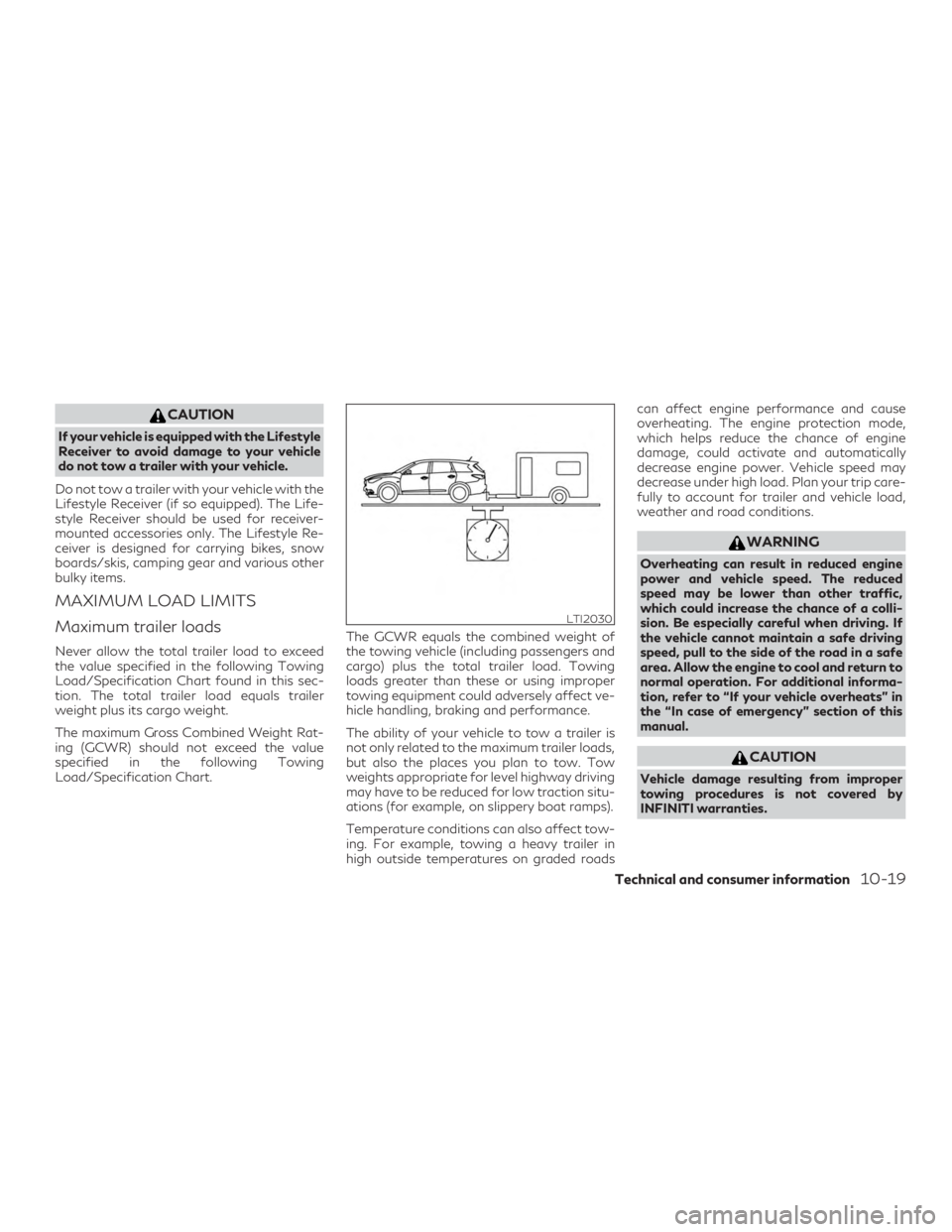
CAUTION
If your vehicle is equipped with the Lifestyle
Receiver to avoid damage to your vehicle
do not tow a trailer with your vehicle.
Do not tow a trailer with your vehicle with the
Lifestyle Receiver (if so equipped). The Life-
style Receiver should be used for receiver-
mounted accessories only. The Lifestyle Re-
ceiver is designed for carrying bikes, snow
boards/skis, camping gear and various other
bulky items.
MAXIMUM LOAD LIMITS
Maximum trailer loads
Never allow the total trailer load to exceed
the value specified in the following Towing
Load/Specification Chart found in this sec-
tion. The total trailer load equals trailer
weight plus its cargo weight.
The maximum Gross Combined Weight Rat-
ing (GCWR) should not exceed the value
specified in the following Towing
Load/Specification Chart. The GCWR equals the combined weight of
the towing vehicle (including passengers and
cargo) plus the total trailer load. Towing
loads greater than these or using improper
towing equipment could adversely affect ve-
hicle handling, braking and performance.
The ability of your vehicle to tow a trailer is
not only related to the maximum trailer loads,
but also the places you plan to tow. Tow
weights appropriate for level highway driving
may have to be reduced for low traction situ-
ations (for example, on slippery boat ramps).
Temperature conditions can also affect tow-
ing. For example, towing a heavy trailer in
high outside temperatures on graded roadscan affect engine performance and cause
overheating. The engine protection mode,
which helps reduce the chance of engine
damage, could activate and automatically
decrease engine power. Vehicle speed may
decrease under high load. Plan your trip care-
fully to account for trailer and vehicle load,
weather and road conditions.
WARNING
Overheating can result in reduced engine
power and vehicle speed. The reduced
speed may be lower than other traffic,
which could increase the chance of a colli-
sion. Be especially careful when driving. If
the vehicle cannot maintain a safe driving
speed, pull to the side of the road in a safe
area. Allow the engine to cool and return to
normal operation. For additional informa-
tion, refer to “If your vehicle overheats” in
the “In case of emergency” section of this
manual.
CAUTION
Vehicle damage resulting from improper
towing procedures is not covered by
INFINITI warranties.
LTI2030
Technical and consumer information10-19
Page 547 of 573
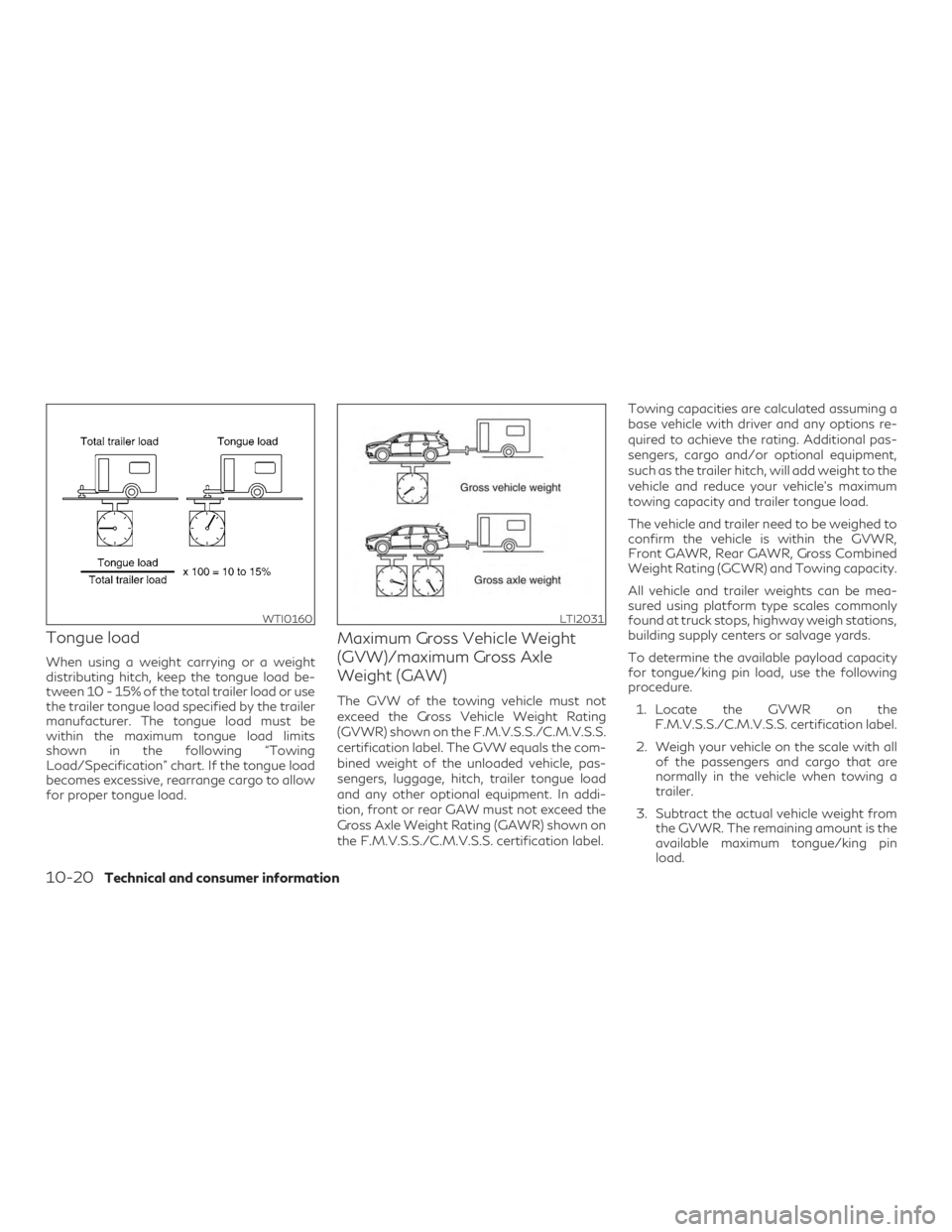
Tongue load
When using a weight carrying or a weight
distributing hitch, keep the tongue load be-
tween 10 - 15% of the total trailer load or use
the trailer tongue load specified by the trailer
manufacturer. The tongue load must be
within the maximum tongue load limits
shown in the following “Towing
Load/Specification” chart. If the tongue load
becomes excessive, rearrange cargo to allow
for proper tongue load.
Maximum Gross Vehicle Weight
(GVW)/maximum Gross Axle
Weight (GAW)
The GVW of the towing vehicle must not
exceed the Gross Vehicle Weight Rating
(GVWR) shown on the F.M.V.S.S./C.M.V.S.S.
certification label. The GVW equals the com-
bined weight of the unloaded vehicle, pas-
sengers, luggage, hitch, trailer tongue load
and any other optional equipment. In addi-
tion, front or rear GAW must not exceed the
Gross Axle Weight Rating (GAWR) shown on
the F.M.V.S.S./C.M.V.S.S. certification label.Towing capacities are calculated assuming a
base vehicle with driver and any options re-
quired to achieve the rating. Additional pas-
sengers, cargo and/or optional equipment,
such as the trailer hitch, will add weight to the
vehicle and reduce your vehicle’s maximum
towing capacity and trailer tongue load.
The vehicle and trailer need to be weighed to
confirm the vehicle is within the GVWR,
Front GAWR, Rear GAWR, Gross Combined
Weight Rating (GCWR) and Towing capacity.
All vehicle and trailer weights can be mea-
sured using platform type scales commonly
found at truck stops, highway weigh stations,
building supply centers or salvage yards.
To determine the available payload capacity
for tongue/king pin load, use the following
procedure.
1. Locate the GVWR on the F.M.V.S.S./C.M.V.S.S. certification label.
2. Weigh your vehicle on the scale with all of the passengers and cargo that are
normally in the vehicle when towing a
trailer.
3. Subtract the actual vehicle weight from the GVWR. The remaining amount is the
available maximum tongue/king pin
load.
WTI0160LTI2031
10-20Technical and consumer information
Page 548 of 573
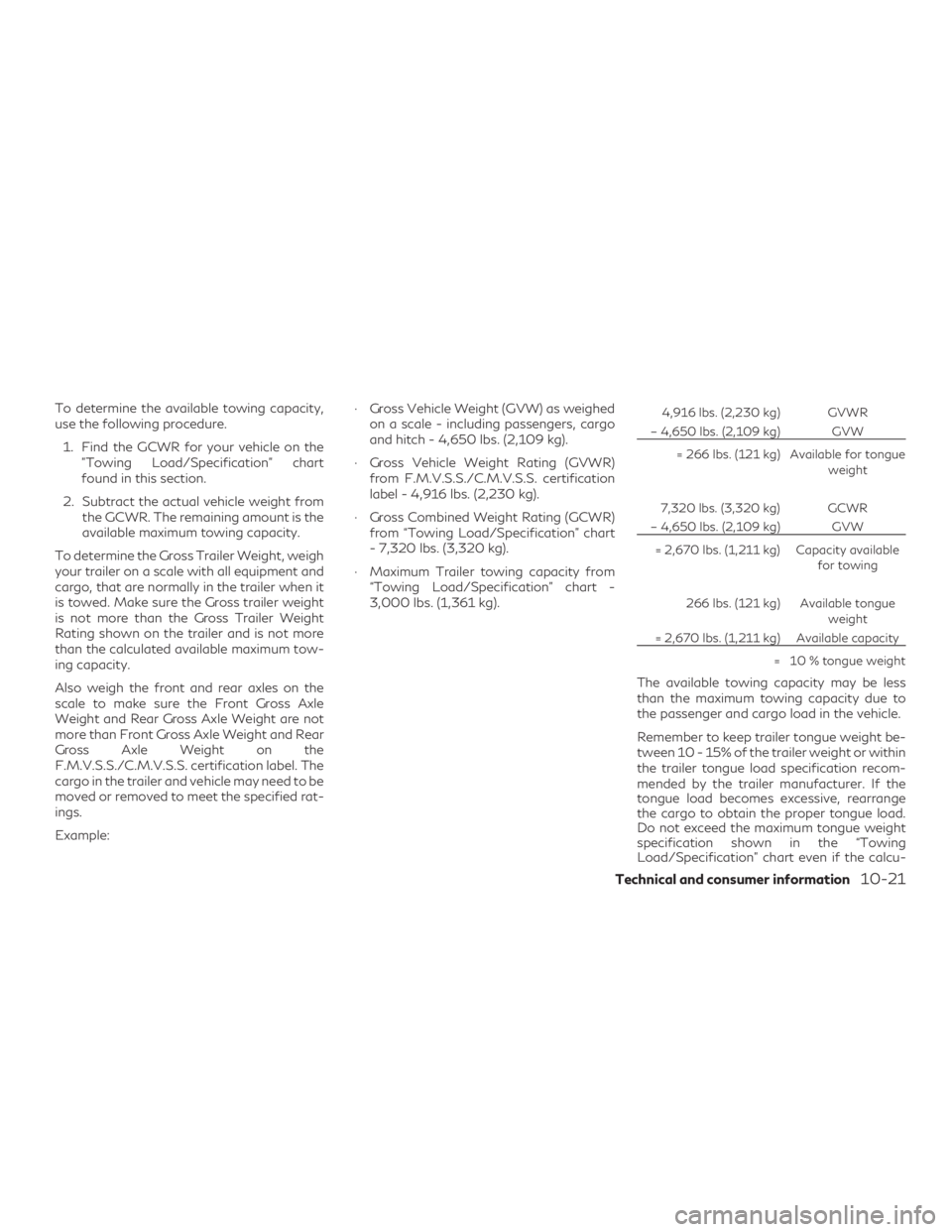
To determine the available towing capacity,
use the following procedure.1. Find the GCWR for your vehicle on the "Towing Load/Specification" chart
found in this section.
2. Subtract the actual vehicle weight from the GCWR. The remaining amount is the
available maximum towing capacity.
To determine the Gross Trailer Weight, weigh
your trailer on a scale with all equipment and
cargo, that are normally in the trailer when it
is towed. Make sure the Gross trailer weight
is not more than the Gross Trailer Weight
Rating shown on the trailer and is not more
than the calculated available maximum tow-
ing capacity.
Also weigh the front and rear axles on the
scale to make sure the Front Gross Axle
Weight and Rear Gross Axle Weight are not
more than Front Gross Axle Weight and Rear
Gross Axle Weight on the
F.M.V.S.S./C.M.V.S.S. certification label. The
cargo in the trailer and vehicle may need to be
moved or removed to meet the specified rat-
ings.
Example: ∙ Gross Vehicle Weight (GVW) as weighed
on a scale - including passengers, cargo
and hitch - 4,650 lbs. (2,109 kg).
∙ Gross Vehicle Weight Rating (GVWR) from F.M.V.S.S./C.M.V.S.S. certification
label - 4,916 lbs. (2,230 kg).
∙ Gross Combined Weight Rating (GCWR) from “Towing Load/Specification" chart
- 7,320 lbs. (3,320 kg).
∙ Maximum Trailer towing capacity from “Towing Load/Specification" chart -
3,000 lbs. (1,361 kg).4,916 lbs. (2,230 kg) GVWR
– 4,650 lbs. (2,109 kg) GVW
= 266 lbs. (121 kg) Available for tongue weight
7,320 lbs. (3,320 kg) GCWR
– 4,650 lbs. (2,109 kg) GVW
= 2,670 lbs. (1,211 kg) Capacity available for towing
266 lbs. (121 kg) Available tongue weight
= 2,670 lbs. (1,211 kg) Available capacity
= 10 % tongue weight
The available towing capacity may be less
than the maximum towing capacity due to
the passenger and cargo load in the vehicle.
Remember to keep trailer tongue weight be-
tween 10 - 15% of the trailer weight or within
the trailer tongue load specification recom-
mended by the trailer manufacturer. If the
tongue load becomes excessive, rearrange
the cargo to obtain the proper tongue load.
Do not exceed the maximum tongue weight
specification shown in the “Towing
Load/Specification” chart even if the calcu-
Technical and consumer information10-21
Page 549 of 573
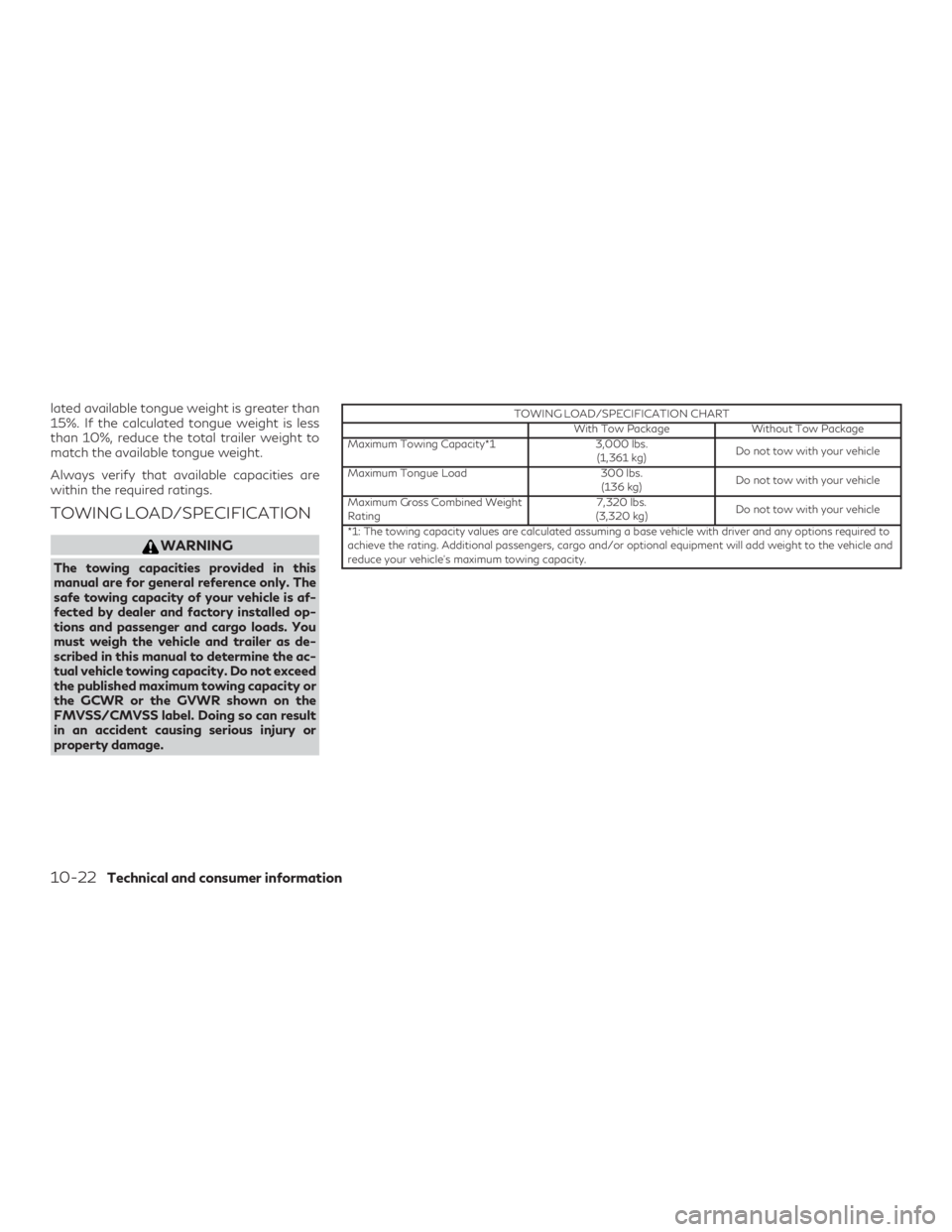
lated available tongue weight is greater than
15%. If the calculated tongue weight is less
than 10%, reduce the total trailer weight to
match the available tongue weight.
Always verify that available capacities are
within the required ratings.
TOWING LOAD/SPECIFICATION
WARNING
The towing capacities provided in this
manual are for general reference only. The
safe towing capacity of your vehicle is af-
fected by dealer and factory installed op-
tions and passenger and cargo loads. You
must weigh the vehicle and trailer as de-
scribed in this manual to determine the ac-
tual vehicle towing capacity. Do not exceed
the published maximum towing capacity or
the GCWR or the GVWR shown on the
FMVSS/CMVSS label. Doing so can result
in an accident causing serious injury or
property damage.
TOWING LOAD/SPECIFICATION CHARTWith Tow Package Without Tow Package
Maximum Towing Capacity*1 3,000 lbs.
(1,361 kg) Do not tow with your vehicle
Maximum Tongue Load 300 lbs.
(136 kg) Do not tow with your vehicle
Maximum Gross Combined Weight
Rating 7,320 lbs.
(3,320 kg) Do not tow with your vehicle
*1: The towing capacity values are calculated assuming a base vehicle with driver and any options required to
achieve the rating. Additional passengers, cargo and/or optional equipment will add weight to the vehicle and
reduce your vehicle’s maximum towing capacity.
10-22Technical and consumer information
Page 550 of 573
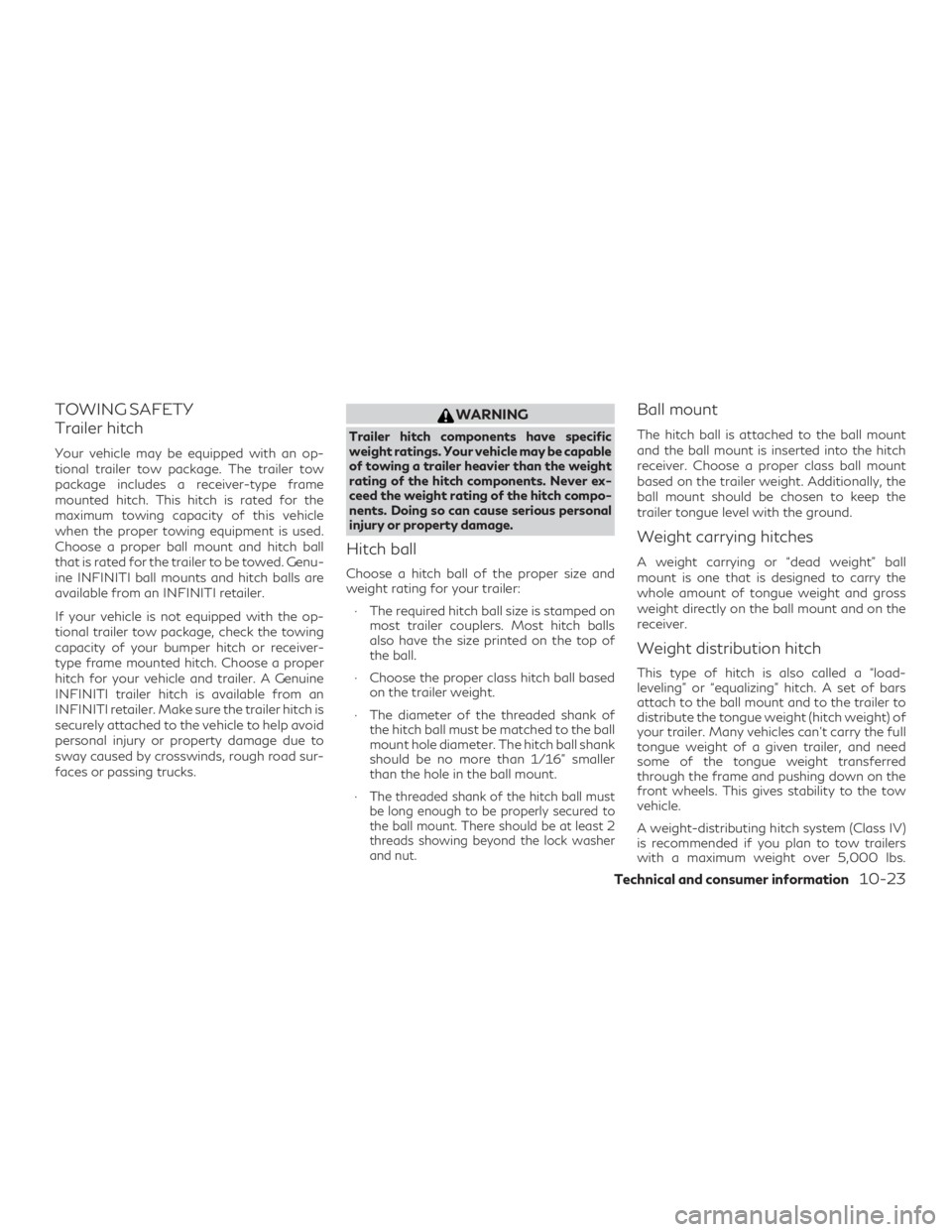
TOWING SAFETY
Trailer hitch
Your vehicle may be equipped with an op-
tional trailer tow package. The trailer tow
package includes a receiver-type frame
mounted hitch. This hitch is rated for the
maximum towing capacity of this vehicle
when the proper towing equipment is used.
Choose a proper ball mount and hitch ball
that is rated for the trailer to be towed. Genu-
ine INFINITI ball mounts and hitch balls are
available from an INFINITI retailer.
If your vehicle is not equipped with the op-
tional trailer tow package, check the towing
capacity of your bumper hitch or receiver-
type frame mounted hitch. Choose a proper
hitch for your vehicle and trailer. A Genuine
INFINITI trailer hitch is available from an
INFINITI retailer. Make sure the trailer hitch is
securely attached to the vehicle to help avoid
personal injury or property damage due to
sway caused by crosswinds, rough road sur-
faces or passing trucks.
WARNING
Trailer hitch components have specific
weight ratings. Your vehicle may be capable
of towing a trailer heavier than the weight
rating of the hitch components. Never ex-
ceed the weight rating of the hitch compo-
nents. Doing so can cause serious personal
injury or property damage.
Hitch ball
Choose a hitch ball of the proper size and
weight rating for your trailer:∙ The required hitch ball size is stamped on most trailer couplers. Most hitch balls
also have the size printed on the top of
the ball.
∙ Choose the proper class hitch ball based on the trailer weight.
∙ The diameter of the threaded shank of the hitch ball must be matched to the ball
mount hole diameter. The hitch ball shank
should be no more than 1/16” smaller
than the hole in the ball mount.
∙
The threaded shank of the hitch ball must
be long enough to be properly secured to
the ball mount. There should be at least 2
threads showing beyond the lock washer
and nut.
Ball mount
The hitch ball is attached to the ball mount
and the ball mount is inserted into the hitch
receiver. Choose a proper class ball mount
based on the trailer weight. Additionally, the
ball mount should be chosen to keep the
trailer tongue level with the ground.
Weight carrying hitches
A weight carrying or “dead weight” ball
mount is one that is designed to carry the
whole amount of tongue weight and gross
weight directly on the ball mount and on the
receiver.
Weight distribution hitch
This type of hitch is also called a “load-
leveling” or “equalizing” hitch. A set of bars
attach to the ball mount and to the trailer to
distribute the tongue weight (hitch weight) of
your trailer. Many vehicles can’t carry the full
tongue weight of a given trailer, and need
some of the tongue weight transferred
through the frame and pushing down on the
front wheels. This gives stability to the tow
vehicle.
A weight-distributing hitch system (Class IV)
is recommended if you plan to tow trailers
with a maximum weight over 5,000 lbs.
Technical and consumer information10-23